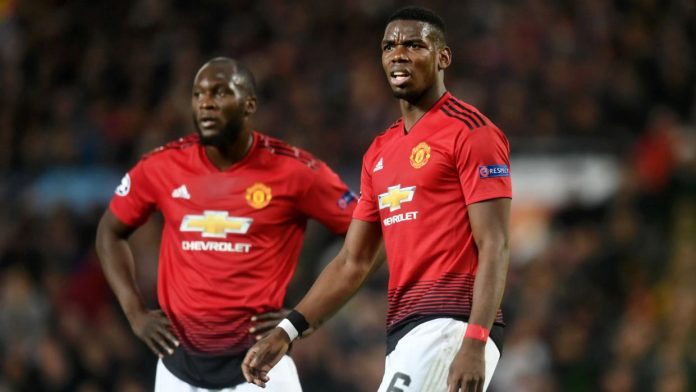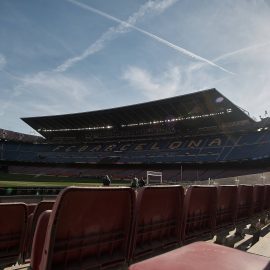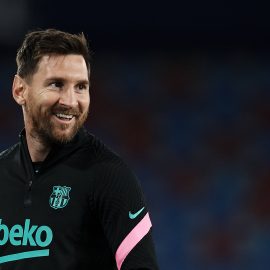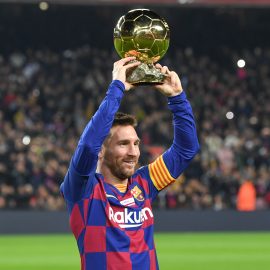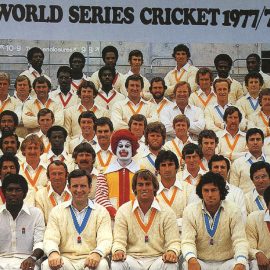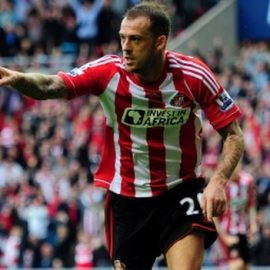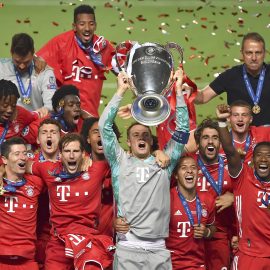The game, at its most basic, is about putting the ball in the back of the net. In order to be a great FORWARD, you have to be able to score. Tracking back on defense is nice. Being a great passer and playmaker is good, too. However if you can’t score, then you won’t be a very effective forward (unless you’re Emile Heskey) and you won’t be very useful to your team.
That being said, in order to be a legendary forward, you need more than just stats. You need to have an aura of invincibility. You need to score on the biggest stages and under the brightest lights. Your goals must lift your squad to victory or bring them back from the edge of defeat. You need to be the player that strikes fear into the hearts of the opposing squad, the one that they single out and say, “We can’t let that guy beat us.”
And even then, you might not be as good as these players were. These legends had eye-popping stats, larger-than-life personalities, and boatloads of trophies. They also became national symbols of pride and in some cases, they represented the hopes and dreams of entire continents. These players were more than just great goal-scorers. They became icons.
There were enough players to create this list that I decided not to go with any current players. Brazilian Ronaldo, despite his brilliance (long before the injuries, weight issues, and tranny hookers, O Fenômeno was on pace to be one of the best that ever lived), and Romario, despite his reputed 1,000 goals, weren’t on the list. As good as Romario was, I don’t think he ranks as a legend quite yet. Plus, would you have taken him, in his prime, over Ronaldo, in his prime? That may be circular logic, but think about it. Romario might not have been the best Brazilian forward over the last 15 years, and he certainly doesn’t hold a candle to Pele or Garrincha. As such, he’s out.
Anyway, here’s the list. In chronological order, of course:
.
.
.
Alfredo Di Stefano |
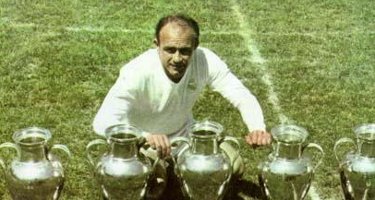 |
|
| ARGENTINA* | ||
| 1943-1966 | ||
| River Plate (1943-1949) Huracan (loan, 1946-1947) Millonarios (1949-1953) Real Madrid (1953-1964) Espanyol (1964-1966) |
||
.
(* Born in Argentina, played for Argentina, Columbia, and Spain. Obviously, FIFA rules were more relaxed back then).
It’s not uncommon to see someone play for several different clubs. But several different national teams? Di Stefano accomplished that rare task by suiting up for his native Argentina, Colombia, and Spain. In the meantime, he established himself as one of the greatest players in football history, a gifted and versatile player on par with the likes of Pele, Maradona, and Cruijff. Maradona once said that Di Stefano was better than Pele, and he was voted the Player of the Century for Spain, despite the fact that he was born in Argentina.
He was known as an exceptionally versatile player, excelling at both offense and defense. He was most well known for his time at Real Madrid, where he scored 216 goals in 282 league matches, making him the club’s all-time leading scorer. He produced a similar ratio at River Plate, scoring 49 goals in 65 appearances, and at Millonarios, notching 88 goals in 102 appearances. For his career, he scored 377 domestic goals in 521 appearances while adding 29 goals in 41 appearances for Argentina, Colombia, and Spain.
At Real Madrid, he formed a deadly partnership with fellow legend, Ferenc Puskas, to help lead the club to glory. He won eight Liga titles, one Copa del Rey, and an impressive five consecutive European Cups with Real Madrid. He also won two Argentine League crowns and four Colombian League titles. He won the Ballon d’Or in 1957 and 1959, and was named World Soccer Player of the Year three times.
His transfer to Real Madrid was extremely controversial as he had initially signed with Barcelona. With doubts over his eligibility causing Barcelona’s board of directors to hesitate over completing the deal, as well as rumors that the Franco Government was working to steer Di Stefano to Real Madrid, Los Meringues were able to swoop in and sign him. To add insult to injury, Di Stefano played extremely well during the first meeting of the year between Real Madrid and Barcelona, netting a hat trick and exacerbating tensions between the two clubs.
Di Stefano’s uncertain international status meant that he was unable to play in the 1954 World Cup. He acquired Spanish citizenship in 1956 and played in Spain’s World Cup qualifiers. His adopted country failed to qualify for the 1958 World Cup. Di Stefano helped Spain qualify in 1962, but an injury ruled him out before the start of the tournament. Despite having never played in a World Cup, Di Stefano accomplished so much in his long and storied career that he remains one of the best goal-scorers of all time.
Alfredo Di Stefano VIDEO:
.
.
.
Ferenc Puskás |
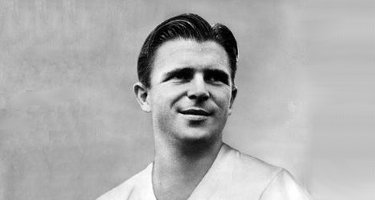 |
|
| HUNGARY |  |
|
| 1943-1966 | ||
| Kispest A.C. (1943-1949) Honved (1949-1955) Espanyol (guest 1957) Real Madrid (1958-1966) |
||
.
Like his celebrated teammate at Real Madrid, Alfredo Di Stefano, Puskás was a goal machine who became a naturalized Spanish citizen. Like Di Stefano, Puskás had an enviable goal-to-games ratio, netting 187 goals in 177 league appearances for Kispest A.C., 165 goals in 164 league appearances for Honved, and 157 goals in 182 league appearances for Real Madrid. Throw in his 84 goals in 85 appearances for Hungary, and Puskás was unquestionably one of the most efficient scorers of all time.
He was a deadly left-footed shooter who could set up goals just as well as he could score them. He certainly didn’t look the part of a goal scorer, being short, stocky, and unable to shoot with his right foot. However, he was regarded as one of the greatest outside shooters of all time, and, well, the stats speak for themselves.
He was part of the “Mighty Magyars,” a talent-laden Hungarian National Team that was favored to win the World Cup in 1954. Puskás did his part in the group stage, scoring three goals in the first two matches before getting injured. He didn’t return until the Finals, and was hobbled and out of form as West Germany (who had lost to Hungary by a score of 8-3 in the group stage) upset them. Despite his injury, he scored the first of Hungary’s two goals, and he thought he scored the equalizer until he was controversially ruled off-side. He suited up for Spain in the 1962 World Cup, but failed to score any goals.
Puskás was on tour in Spain with Honved when the Revolution of 1956 broke out in Hungary. Puskás decided to defect to Spain, and the ensuing controversy over his immigration status found him banned from football for two years. He played in a few unofficial matches for Espanyol before signing with Real Madrid. There, he teamed with fellow immigrant Alfredo Di Stefano to give the club a dominant strike force. Their dominance was on display during the 1960 European Cup Final, when Real Madrid defeated Eintracht Frankfurt by a score of 7-3, with Puskás scoring four goals and Di Stefano adding three. Puskás won five La Liga crowns and was a member of the team for three out of Real Madrid’s five consecutive European Cups. He also won five Hungarian League crowns and was named FIFA World Player of the Year twice.
Despite his defection, Puskás remains revered in Hungary. He was named the country’s greatest player of the last 50 years, and the Puskás Ferenc Stadion in Budapest was named in his honor.
Ferenc Puskás VIDEO:
.
.
.
Garrincha |
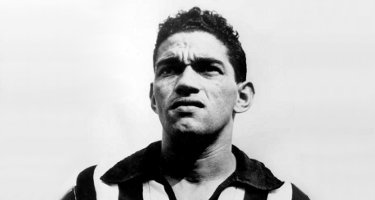 |
|
| BRAZIL |  |
|
| 1953-1972 | ||
| Botafogo (1953-1965) Corinthians (1966) Portuguesa Carioca (1967) Atlético Junior (1968) Flamengo (1968-1969) Olaria (1972) |
||
.
Considered by many to be the second-best Brazilian forward after Pele, Manuel Francisco dos Santos “Garrincha” (“little bird” in Portuguese) established himself as one of the greatest dribblers of all time. Not bad for someone who was born with several birth defects, including a right leg that bent inwards and a left leg that was slightly shorter than his right and curved outwards. Those physical deformities didn’t stop him from becoming a great dribbler, and he supposedly earned his first professional contract by dribbling a ball through the great Nilton Santos’s legs during a training session. He was able to use his handicap to his advantage, as opposing players could never tell which way he was going to go when he started dribbling the ball.
In addition to his dribbling skills, he was a great shooter who could score with either foot. He was also a great free-kicker and dead-ball specialists who often took corners for his team, scoring three goals directly from corner kicks. Garrincha operated from the right wing a lot, and he could use his speed and dribbling to get past defenders and set up goal chances for himself or for his teammates. He was also a good header, despite standing 5’7”.
He made 612 appearances for Botafogo, scoring 243 times. He won the Campeonato Carioca (Rio de Janeiro Tournament) three times, the Torneio Rio-São Paulo (Rio/Sao Paulo tournament) three times, and the Roca Cup, a tournament between Brazilian and Argentinean clubs.
He had his greatest success on the international stage, where he was a part of the 1958 and 1962 World Cup winning squads for Brazil. He was voted to the Best XI in the 1958 World Cup, despite only playing in 4 matches and not scoring a single goal. He was responsible for setting both of Vava’s goals in the Final against Sweden, and he was dominant in matches against the USSR and Wales. In 1962, he continued his success for the Brazilian national team, as he was voted Most Outstanding Player of the World Cup. He carried his team after Pele was injured early in the tournament, and finished with four goals. He scored a number of dazzling goals, including the famed “Banana Shot” against England, and had a brace in the Semi-Finals against Chile.
Garrincha was known for his child-like demeanor and was seen as an idiot savant. He was never a huge football fan and had never dreamed of playing professionally until just before he signed with Botafogo. He didn’t understand the rules of the World Cup and was decidedly low-key after they won in 1958. Apparently, he thought they were going to play all the teams again, so he refrained from celebrating until he realized his team had won it all. He was also known as “Mané” (short for “Manuel” but which also means “half-wit/fool”) by his teammates. Despite his perceived lack of intelligence, his prodigious talent and natural ability was more than enough for him to attain legendary status.
Garrincha VIDEO:
.
.
.
Pele |
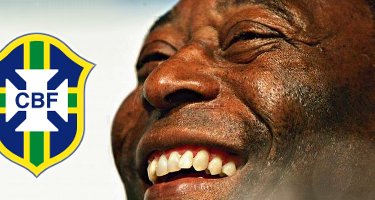 |
|
| BRAZIL |  |
|
| 1956-1977 | ||
| Santos (1956-1974) New York Cosmos (1975-1977) |
||
.
There are legends, there are icons, and then there’s Pele. Without question, Pele is the greatest player of all time, someone whose talent transcended the game. If you don’t know anything else about football, you know that Pele was the best. Much like how Jimi Hendrix is considered to be greatest guitarist that ever lived and Michael Jordan is the greatest basketball player of all time, Pele is the greatest footballer ever to walk the planet. Some people might come up with contrarian arguments, just to be different. They might say that Maradona was better, just like how some people claim that Clapton was better than Hendrix or that Oscar Robertson was better than Jordan.
Don’t buy it.
Pele scored 1,281 goals, a number made all the more remarkable since these are just the ones recognized by FIFA. By contrast, Romario claimed to have scored 1,000 goals, however some of them came during his days with the youth team and others were in unsanctioned events. He scored 77 goals in 92 appearances for Brazil, and scored 589 domestic goals in 605 appearances. When he came out of retirement to play for the Cosmos, he managed to bag 31 goals in 56 games while doing something that David Beckham couldn’t do, namely, turning the Cosmos into an American phenomenon.
He revolutionized the forward position, blending his playmaking skills with his deadly shot to become the ultimate weapon. He was a great dribbler and passer, and was blessed with blistering pace and exception aerial skills. He made the number 10 shirt synonymous with his playmaking abilities, and as a result, he turned what had been a random shirt assignment into a coveted number usually reserved for a team’s best player. Whenever teams say that they’re looking for a “number 10,” they’re really referring to Pele.
He was a part of four World Cup squads, winning three of them. He won 25 trophies while playing with Santos, and added to his cabinet with an NASL Title while with the Cosmos. He has a whole slew of individual and lifetime achievement awards, which are too many to name. Suffice it to say that it’s a bigger story when Pele doesn’t win an award than when he does.
He is a national icon, a global ambassador for the game, and a philanthropist who has used his fame to help those less fortunate than he is. Based on his playing statistics alone, he would be the greatest player of all time. However, his off-the-field activities make him a true legend, and an icon that everyone can embrace.
Pele VIDEO:
.
.
.
Eusebio |
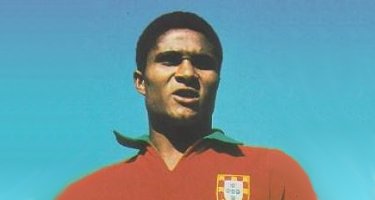 |
|
| PORTUGAL |  |
|
| 1957-1978 | ||
| Sporting Lourenço Marques (1957-1960) Benfica (1960-1975) Rhode Island Oceaneers (1975) Boston Minutemen (1975) Monterrey (1975-1976) Beira-Mar (1976-1977) Toronto Metros-Croatia (1976) Las Vegas Quicksilver (1977) New Jersey Americans (1977-1978) União Tomar (1977-1978) |
||
.
Widely considered to be the greatest Portuguese player of all time, the Mozambique-born Eusebio also gained fame as one of the first great players of African descent. “The Black Panther” spent most of his career at Benfica, where he 319 goals in 313 appearances, including two seasons where he topped 40. However, he also played in other parts of the world, notably the United States, Croatia, Canada, and Mexico, making him one of the true worldwide icons of the sport.
Eusebio won plenty of silverware during his time at Benfica. He won eleven League titles, five Portuguese Cups, and won the European Cup in 1962. He also won titles in the NASL and in Mexico. Eusebio won plenty of individual honors as well, taking home the Ballon d’Or in 1965 and won the very first Golden Boot award in 1968, knocking home 42 goals for Benfica. He won a second Golden Boot award in 1973 with another 40 goals, and led the Portuguese League in scoring seven times.
He continued his goal scoring ways for the Portuguese national team, notching 41 goals in 64 appearances. He led Portugal to a third-place finish in the 1966 World Cup, losing to eventual winners England in the Semi-Finals. Eusebio scored the lone Portuguese goal in that match and finished with a tournament-high 9 goals. Most notably, he scored on a penalty in the consolation match against the USSR by beating the great Lev Yashin, which was no small feat. He finished his Portuguese career as the all-time leading scorer, a record that stood until 2005. He may not be Portugal’s leading scorer anymore, but he remains the most beloved and respected Portuguese player of all time.
Eusebio VIDEO:
.
.
.
Gerd Müller |
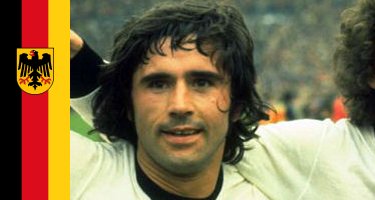 |
|
| GERMANY | ||
| 1963-1981 | ||
| TSV 1861 Nördlingen (1963-1964) Bayern Munich (1964-1979) Fort Lauderdale Strikers (1979-1981) |
||
.
The phrase “Goal Machine” gets thrown around a lot. Müller, however, more than lived up to his reputation as a goal scorer, finding the net an astonishing 365 times in 427 Bundesliga matches, and 68 times in 62 international appearances. Müller wasn’t very tall (5’9”), wasn’t very fast, and had short stubby legs that made him look like the last person capable of scoring on the pitch. However, his short, powerful legs allowed him to accelerate past defenders with ease, stay on his feet even after being tackled by defenders, and gave him a surprising amount of leverage in winning headers.
Known as “Bomber der Nation” (the nation’s bomber), Müller, along with Sepp Maier and Franz Beckenbauer, was part of the great Bayern Munich teams of the 70’s. He won four Bundelisga titles, four German Cups, one Cup Winners’ Cup, and three consecutive European Cups from 1974-1976. He led the Bundesliga in scoring seven times and won the Golden Boot twice. He still holds the Bundesliga’s single-season scoring record with 40 goals in 1971-1972, and his 66 goals in 72 European Cup matches is still a record. He is, by far, the all-time leading scorer in Bundesliga history, having scored nearly 100 more goals than the person in second place.
His success continued to the international stage, as he was part of the Golden Generation of West German football. He was part of the 1972 European Championship squad and provided the goal scoring that led West Germany to the 1974 World Cup. Playing in his final international match, Müller scored the game-winning goal in the Final against the Netherlands. He finished his World Cup career with 14 goals, a record that stood until Ronaldo passed it in 2006.
He has continued his involvement with Bayern Munich, coaching the reserve team. Unlike his fellow German icons, Maier and Beckenbauer, he has kept a low profile following his retirement, choosing not to voice his opinion on controversial matters relating to German football. Despite his low-key approach, Müller remains one of the most beloved and respected players of all time.
Gerd Müller VIDEO:
.
.
.
George Weah |
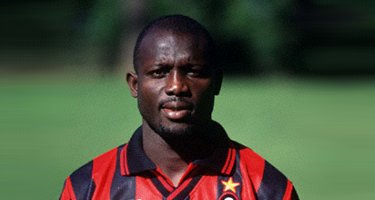 |
|
| LIBERIA |  |
|
| 1981-2003 | ||
| Young Survivors (1981-1984) Bongrange Company (1984-1985) Mighty Barolle (1985-1986) Invincible Eleven (1986-1987) Tonnerre Yaoundé (1987-1988) AS Monaco (1988-1992) Paris Saint-Germain (1992-1995) A.C. Milan (1995-2000) Chelsea (2000) Manchester City (2000) Olympique Marseille (2000-2001) Al-Jazira (2001-2003) |
||
.
Sometimes, calling someone a legend doesn’t do that person nearly enough justice. George Weah is an example of that. His on-field accomplishments were impressive, however they didn’t come close to measuring his impact on the game. Coming from the tiny and war-torn country of Liberia, Weah used his success and his status as one of the best in the world to improve conditions in his home.
Weah was a great player in his own right. He was big and strong and had a powerful shot. He was a no-frills player who frequently ran straight at opponents, using his strength but also mixing in some excellent ball-control skills. He was a great header of the ball, and he had good speed for someone his size. He scored against Verona after taking a ball from his own penalty box and running through the defense a lot like how Maradona knifed through the England defense in the World Cup.
He was an excellent goal scorer and thrived under Arsene Wenger at Monaco before moving to PSG and AC Milan. He won a French League Title and three French Cups to go with his two Scudetti and FA Cup from his time at Milan and Chelsea, respectively. He never made the World Cup, although he came close in 2002, when a weak and under-funded Liberia missed out by a single point. He remains the only African player to have won the Ballon d’Or and FIFA World Player of the Year, a task he accomplished in 1995. He was also voted African Player of the Century.
Naturally, Weah became a politician and ran for President in 2005 after the second Liberian Civil War and the resignation and exile former President (and indicted war criminal) Charles Taylor. Weah was seen as the “People’s Candidate” and he managed to win the initial round of balloting, only to lose in the runoff amid allegations of massive voter fraud. Weah eventually conceded, however he remains popular and committed to improving life in his home country.
George Weah VIDEO:
.
.
.
Marco van Basten |
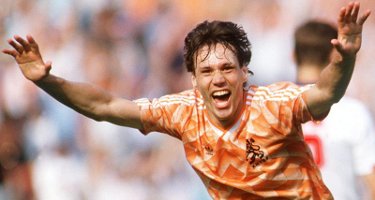 |
|
| NETHERLANDS |  |
|
| 1982-1993 | ||
| Ajax Amsterdam (1982-1987) AC Milan (1987-1993) |
||
.
His career was cut short by injuries, but what a career it was! Van Basten had an incredible goals-to-games ratio for both club and country. He found the net 218 times in 280 league appearances in both the Netherlands and Italy, and he scored 24 times in 58 appearances for the national team. In all, he scored 301 goals in 428 total appearances for club and country.
His main attribute was his strength on the ball, which allowed him to score in crowded areas. Indeed, he was so big and strong that he seemed to invite hard challenges from defenders, leading to his career-ending injury. Despite his size and strength, he was extremely agile and skilled, capable of scoring off bicycle kicks and overhead kicks. He was also known for his thunderous shot, which allowed him to score from distance as well.
He won three Eredivisie titles, three Dutch Cups, and one UEFA Cup during his time at Ajax, and added three Serie A titles, three Italian Supercups, and back-to-back European Cups (1988 and 1989). Along the way, he racked up a slew of individual honors, including the Golden Boot for the 1985-1986 season when he scored 37 goals in 26 league appearances for Ajax. He won the Ballon d’Or three times (1988, 1989, 1992), World Soccer Player of the Year twice (1988, 1992), FIFA World Player of the Year once (1992), and UEFA Player of the Year three times (1989, 1990, 1992). More amazingly, he led the Eredivisie in scoring every single season he played at Ajax, except for his rookie season, and was the top scorer in Serie A twice (1989-1990, 1991-1992).
He won Euro 88, scoring 5 goals, including a hat trick against England and their legendary goalkeeper Peter Shilton in the group stage. He also led the Netherlands to the semi-finals of Euro 1992, where they lost to Denmark in a shootout. Van Basten only played in one World Cup, which was in 1990. His Netherlands team lost to eventual champions West Germany in the Round of 16.
Van Basten eventually retired because of a serious ankle injury. His career may have been cut short, but his brilliance was unquestionable.
Marco van Basten VIDEO:
.
.
.
Hristo Stoichkov |
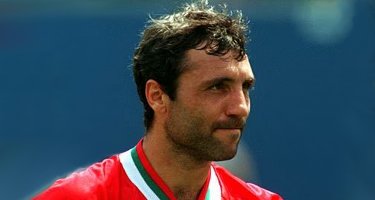 |
|
| BULGARIA |  |
|
| 1982-2003 | ||
| Hebros Harmanli (1982-1984) CSKA Sofia (1984-1990, 1998) FC Barcelona (1990-1995, 1996-1998) Parma (1995-1996) Al-Nassr (1998) Kashiwa Reysol (1998) Chicago Fire (2000-2002) DC United (2003) |
||
.
The fiery forward was known for his explosive dribbling and shooting and his equally explosive temper on the pitch. He was an excellent free-kick taker and played most of his career on the left side of the field, where his pace and dribbling gave defenders fits and his great crossing skills produced opportunities for his teammates. His on field tantrums and antics didn’t detract from his legendary status, though, and he was voted to FIFA’s 100 and was named Bulgaria’s greatest player of the last 50 years.
Stoichkov’s well traveled career saw him star at CSKA Sofia and Barcelona, where he had his best years. He won three Bulgarian League titles, four Bulgarian Cups, and was awarded the Golden Boot in 1989 after scoring 38 goals in 30 games for CSKA Sofia. At Barcelona, he experienced even more success by winning five La Liga crowns, one Copa del Rey, one Cup Winner’s Cup, and one European Cup.
Despite Bulgaria’s lack of strength on the international stage, Stoichkov was able to achieve some success while representing his country. At the 1994 World Cup, he led Bulgaria to the Semi-Finals, where they lost to Italy, 2-1. Stoichkov was the co-leading scorer of the tournament with six goals, and half of them came in the knock out round. He scored the equalizer against Germany in the Quarterfinals, and scored Bulgaria’s lone goal against Mexico in the Round of 16. Along the way, Stoichkov also scored against Argentina, helping to lead his country to a huge upset of one of the pre-tournament favorites (FYI: this was the first match Argentina played after Maradona was thrown out). Bulgaria finished fourth, which was their best World Cup showing.
With Stoichkov, controversy was never far away, and he amassed an impressive resume when it came to on-the-field incidents. He was once suspended for two months after stomping on a referee’s foot. He also broke an opposing player’s leg while playing in MLS. As a manager, he’s continued his controversial ways, clashing with players and getting sent off in matches for arguing with referees. Clearly, he has not mellowed with age.
Hristo Stoichkov VIDEO:
.
.
.
Roberto Baggio |
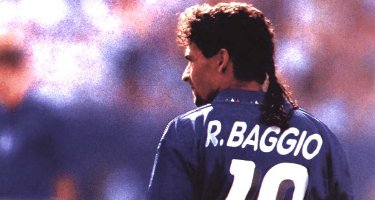 |
|
| ITALY | ||
| 1982-2004 | ||
| Vicenza (1982-1985) Fiorentina (1985-1990) Juventus (1990-1995) AC Milan (1995-1997) Bologna (1997-1998) Inter Milan (1998-2000) Brescia (2000-2004) |
||
.
One of the most popular Italian players to play the game, Baggio more than lived up to the adoration and adulation of the fans. With his good looks and charisma, he became a bonafide superstar and ranks as possibly the most famous Italian player of all time. He wasn’t just flash, though, as he averaged nearly a goal every two matches despite playing his entire career in defensive-minded Italy, and he scored 27 times in 56 appearances for the Italian national team. Even his playing style was attractive, as he became known for his dazzling runs into the box, his ability to elude defenders, and his skill at flicking passes or shots with either foot.
Baggio won Serie A titles with both Juventus and AC Milan. He also won a Coppa Italia while with Juventus, and added a UEFA Cup title to his haul in 1995. Baggio won the Ballon d’Or and the FIFA World Player of the Year Award in 1993, after leading Juventus to the UEFA Cup and scoring 30 goals in all competitions. In 2002, he was named to FIFA’s All-Time Dream Team, alongside players like Pele, Maradona, Beckenbauer, Cruijff, and Platini.
Obviously, he is most famous (or infamous) for missing a penalty kick during the shootout in the 1994 World Cup Final against Brazil. While his miss didn’t cost the Italians the match, as Brazil were ahead and would have won if they had converted their next kick, his miss clinched the title for Brazil. The miss overshadowed what had been a great tournament for him, as he named to the World Cup Starting XI and his 5 goals were tied for second-most among all players. He also played well in 1990, scoring the “Goal of the Tournament” against Czechoslovakia, and in 1998, when he became the first Italian player to score in three World Cups.
He accomplished so much and he was such a special player that it’s a shame that many people only know about his penalty miss in 1994.
Roberto Baggio VIDEO:
.
.
.
Text & Career Summaries by Victor Li. Formatting and Image Research by Marco Pantanella.
Back to Football Legends homepage.
Add Sportslens to your Google News Feed!
